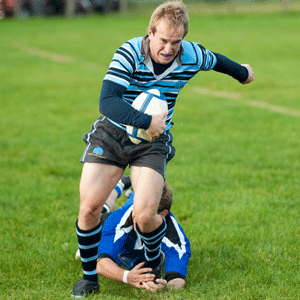
A dislocated shoulder should be treated as a medical emergency. When the shoulder ‘pops’ out of its joint, it can fracture a small piece of bone as it comes out.
In addition, when it is relocated back into place, even if it happens spontaneously, there is a chance that some blood vessels or nerves could get trapped or damaged. The player needs to placed in a sling, and transported to hospital to have an x-ray and be assessed by a Dr to ensure that none of the surrounding structures are damaged.
A knee would need to be quickly assessed on the field to decide how severe the injury is… if the player can walk and there is no immediate swelling or obvious instability, the physio could strap it quickly to support it for the remainder of the match.
If it seems as though the knee is unstable or at risk for further injury of the player continues, they need to be removed from the field.
Read: Preventing injuries on the rugby field
This is how a physiotherapist would treat dislocation at a rugby match:
Evaluation and reduction
Traumatic dislocations should always be evaluated by a medical doctor, physiotherapist or emergency personnel and the dislocation should be reduced as soon as possible by a person with adequate knowledge of the procedure. The shoulder joint is a high risk area for arterial and nerve impingement.
Radiological evaluation
The joint should preferably be evaluated radiographically as well to ensure that the alignment is correct post reduction and to ascertain the extent of ligament damage. In order for a joint to dislocate, something has to give e.g. ligament and or muscles torn. The result of these procedures will dictate the further management e.g. surgery or conservative treatment.
Watch this rugby player in the USA Sevens tournament simply popping his shoulder back into place
Immobilisation
The joint must be immobilised for a period of time (minimum 10 days) depending on the extent of damage. During this period circulation is enhanced through movement of the joints above and below the immobilised joint.
Physiotherapy
Your physiotherapist will be able to assist from directly after the injury through advice and exercises to limit the secondary muscle wasting due to the immobilisation. A correct posture and walking pattern is very important to lessen the time to full recovery as well as prevent chronic pain and lingering pathology.
Read more:
Rugby injuries: new approach recommended
8 recovery techniques the Springboks use to prevent injury
10 things we bet you didn't know about rugby injuries
Image: Skinning your opposition man from iStock




 Publications
Publications
 Partners
Partners











